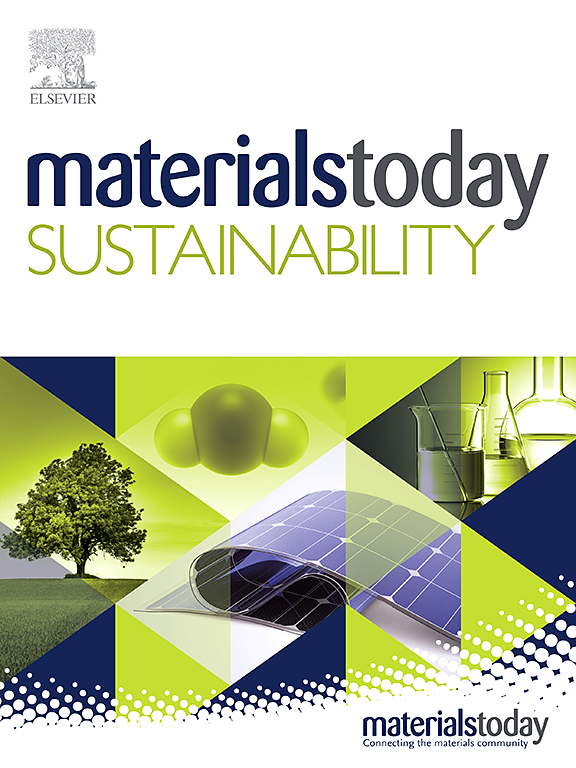可持续保温材料泡沫纤维的开发与评价
IF 7.9
3区 材料科学
Q1 GREEN & SUSTAINABLE SCIENCE & TECHNOLOGY
引用次数: 0
摘要
对可持续隔热材料的需求日益增长,源于与传统石油和矿物材料相关的环境问题,这些材料具有高毒性和全球变暖的潜力。虽然存在生物基替代品,但它们通常面临与化学密集处理、可扩展性和成本效益相关的挑战。本研究探讨了木质纤维素纤维多孔泡沫的生产利用一个简单的和可扩展的机械纤颤过程。开发了两种不同的泡沫配方:一种使用黄原胶(一种天然多糖)作为粘合剂来增强结构完整性,另一种使用硼砂(一种天然矿物盐)来交联纤化纤维中暴露的纤维素。所得到的泡沫具有高度多孔结构,具有增强的化学纤维和机械纤维互连。黄原胶结合泡沫的导热系数为42 mW/m*K,表观密度为21 kg/m3,抗压刚度为56 kPa。硼砂交联泡沫的导热系数为43 mW/m*K,表观密度为11.5 kg/m3,抗压刚度为19 kPa。值得注意的是,尽管天然纤维具有固有的可燃性,但这两种泡沫材料的极限氧指数均为29.5%,属于自熄型。黄原胶结合泡沫在三次循环后也保持了相当的物理和热性能。一项从摇篮到大门的生命周期评估显示,与传统的绝缘材料(特别是硬质聚氨酯和玻璃棉)相比,这种材料的毒性和全球变暖潜力显著降低。这项研究证明了利用直接纤维纤维和模板成型工艺生产具有良好热机械性能、提高消防安全性和减少环境足迹的可持续保温泡沫的可行性。本文章由计算机程序翻译,如有差异,请以英文原文为准。
Development and evaluation of sustainable henequen fibre foams for thermal insulation
The increasing demand for sustainable thermal insulation materials stems from environmental concerns associated with conventional petroleum and mineral-based options, which exhibit high toxicity and global warming potential. While bio-based alternatives exist, they often present challenges related to chemically intensive processing, scalability, and cost-effectiveness. This study investigates the production of porous foams from lignocellulosic henequen fibres utilising a simple and scalable mechanical fibrillation process. Two distinct foam formulations were developed: one employing xanthan gum, a natural polysaccharide, as a binder to enhance structural integrity, and the other utilising borax, a natural mineral salt, to cross-link exposed cellulose in the fibrillated fibres. The resulting foams exhibited a highly porous structure with enhanced chemical and mechanical fibre interconnections. The xanthan gum-bound foam exhibited a thermal conductivity of 42 mW/m*K, an apparent density of 21 , and a compressive stiffness of 56 kPa. The borax-crosslinked foam achieved a thermal conductivity of 43 mW/m*K, an apparent density of 11.5 , and a compressive stiffness of 19 kPa. Notably, both foams demonstrated a limiting oxygen index of 29.5, classifying them as self-extinguishing, despite the inherent flammability of the natural fibres. The xanthan gum-bound foam also maintained comparable physical and thermal properties after three recycling cycles. A cradle-to-gate life cycle assessment revealed significant reductions in toxicity and global warming potential compared to conventional insulation materials, specifically rigid polyurethane and glass wool. This research demonstrates the feasibility of utilising a straightforward fibrillation and template-forming process with abundant henequen fibres to produce sustainable insulation foams with good thermo-mechanical performance, improved fire safety, and a diminished environmental footprint.
求助全文
通过发布文献求助,成功后即可免费获取论文全文。
去求助
来源期刊

Materials Today Sustainability
Multiple-
CiteScore
5.80
自引率
6.40%
发文量
174
审稿时长
32 days
期刊介绍:
Materials Today Sustainability is a multi-disciplinary journal covering all aspects of sustainability through materials science.
With a rapidly increasing population with growing demands, materials science has emerged as a critical discipline toward protecting of the environment and ensuring the long term survival of future generations.
 求助内容:
求助内容: 应助结果提醒方式:
应助结果提醒方式:


